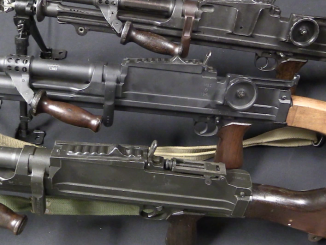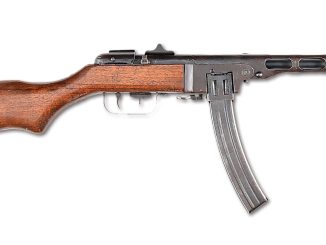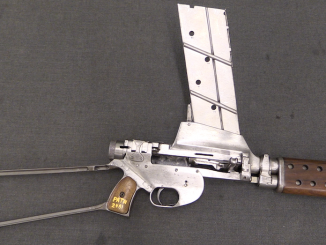The Chinese military introduced a new 5.8x42mm cartridge in 1987, and then developed a new bullpup rifle to use it. The rifle was the QBZ Type 95, and it was a bullpup rifle with a rotating bolt and short-stroke gas pistol operating system. Shortly thereafter, a commercial export version was released in 5.56mm NATO, designated the Type 97. While Norinco rifles are barred from importation into the United States, they have become available in Canada. The rifle we are looking at today is a Canadian import Type 97 NSR.
Thanks to Daniel and Colin for arranging this opportunity for me to take a look at the rifle!




Couple of months ago I had the opportunity to try this creation on range and then, with promise to owner to do thorough cleaning, was able to examine it into detail including taking couple of dimensions.
Sadly, I was nor impressed; if not disappointed together. Some time back I shot Famas and this Chinese thing does not stand comparison. Firstly – we (2 different shooters) were not able to hit target at 10yds. We did not have enough time o fiddle with front sight to remedy it. That handle with built-in sight is POS aa far as I can tell. Also, ejection is pretty severe; I would NOT recommend to anyone to try it using LH cheek – very hazardous proposition.
During disassembly and cleaning I found couple of oddities which in my mind have no place on military firearm – the large plastic grip for one. Yes, there is lots of space around it, but I remain skeptical (also I cannot see how this would sustain a serious impact). Some detail feature I liked – like bolt assembly to some degree, although workmanship was poor (casting/forging with minimum of machining). And yes, the trigger linkage engaged every time; also weight and feel pull was for b-pup not bad. Buffer is of questionable value; linear striker so-so. What I did like was gas piston arrangement and the clever sear mechanism.
I have seen new and updated version in Cabela Canada store with integrated Pic rail. This definitely increases value of this firearm, but as it might sound “cheap” to some for some $1,200 CDN I would not bother.
This gun is apparently quite popular in Canada, because unlike ARs, you can legally shoot it on any range. ARs are restricted to special approved ranges. Because according to Canadian law makers, the spesific type of operating system matters. Go figure, but gun laws are of course crazy like this almost everywhere.
As I understand it, Canadian laws related to private firearms holding (as opposed to owning) is a maze which contain only faint sign of logic. Just consider that you can own pistols (based of appropriate category of your licence), but you cannot walk with them on street. This is incomprehensible to European gun owners/ shooters. But then, firearms possession is “privilege” not right in Canada, just as drivers license or other ‘perks’.
When comes to shooting I gather there are three locations where you can do it. One of course is private land. Second would be crown/ state owned land. This is practically possible in remote locations, away from populated areas (outside of city limits), so some opportunities exist . Third and most common and relatively safe, legally speaking, are ranges. From my experience, shooting clubs are typically not keen on permitting anything bigger than 22 small-bore, although I had been shooting at one as a guest where practically anything including 50 cal. is go.
When comes to other “black” rifles in legal possession in Canada, Tavor is quite popular (although extremely pricey), various versions of vz.58, your mentioned versions of AR15 and lately re-legalized Sig500 series rifles. AK type of weapons are out, although as I recall, after dissolution of Yugoslavia, there was quantity of cheap Zastava rifles on market. They may be still held under provision which is popular under term “grand-fathering”.
But then, if you want to look at it the other way – it is a sign of generosity; it could be retroactively illegal and confiscated, which is not the case. So, little reason to complain.
“Black rifles” are more or less exaggerated by left-wing media. A big-game hunting rifle could probably shoot through the driver and the passenger of a police car yet I don’t see people banning hunting rifles because of ballistic studies. Double rifles don’t look very scary compared to the AK. At least Canada and America have not categorized muzzle-loading rifled muskets as modern military weapons capable of pulling off terrorist stunts, otherwise I’d have to hide such antique long arms in the basement and then hope nobody knew that the antiques ever existed!
That is true; this ‘black rifle’ term is just an gun lingo. Many hunting rifles, if not all are lot more powerful than pipsqueak 223. Lost time on range one fella showed up with some sort of magnum shot rifle at around .340-.350; he said he never bought factory made shot in his life, all hand loaded. Oh boy, when he pulled trigger, I thought the shack will go down.
I thought you agreed not to politicize this site. There are plenty of places for you to express political opinions. I visit Forgotten Weapons because of its technological and historical approach to firearms. Mr McCollum does not introduce such annoyances. Follow his lead. Stick to your historical and technical references and spare us your blathers.
If Denny’s appraisal of the Norinco design tells me anything, it’s that the makers of the Type 97 NSR made the rifle “look good” but not “shoot well.”
This would be akin to the state of the Beiyang Navy during the Battle of the Yalu River. The Chinese ships were impressive in their looks but were rendered practically useless by dud-ammunition and a huge lack of gunnery training for their crews (to say nothing of command incompetence and corruption).
@Stephen
Glad to hear from you Stephen, although I have not seen your name in this blog yet… and I read it for good number of years. I feel you give yourself an unwarranted power to police it, which belongs entirely and uniquely to Mr. McCollum. If he feels that any of my comments were inappropriate, he has the opportunity to come to contact me publicly or privately with appropriate instruction. I shall consequently heed his advice, not yours.
Wishing you good stay on Mr. McCollum’s page, sir!
@Cherndog
Precisely as you say… I did not deny inherent qualities this product contains, just its obvious weakness as I perceived it (could not hit damn target at 100 yards). It most certainly will be improved upon introduction of integral optical rail. I wish importer well in future sales.
“Sadly, I was nor impressed; if not disappointed together. Some time back I shot Famas and this Chinese thing does not stand comparison. Firstly – we (2 different shooters) were not able to hit target at 10yds.”
————————————————————
Sorry, shabby writing. It should read as follows:
Sadly, I was nor impressed; if not disappointed altogether. Some time back I shot Famas and this Chinese thing does not stand comparison. Firstly – we (2 different shooters) were not able to hit target at 100 yards.
Of course Canadians also have oodles of Soviet SKS carbines–with the magazine blocked to 5 rounds, yes? And also SVT-40 Tokarev rifles. Oh, and Cuban cigars! For that matter, honeymoon trips to Vedado or various other beaches currently assailed by Irma. And Tim Hortons! Poutine… Many, many attractions.
Overall, it looks like they took an AK bolt system and instead of the open gas piston system of the AK, they grafted it to the short-stroke piston system of the M1 Carbine, also seen in a slightly modified form on the Ruger Mini-14. That cocking tube assembly would seem to take the place of the side-mounted operating rod/bar of the Garand/Carbine type action.
I give them credit for obeying the KISS principle (Keep It Simple, Stupid). It still has all the basic problems of the bullpup concept, plus in my opinion some poor materiel choices.
I still maintain that the bullpup is an ingenious answer to a question no sensible person ever asked.
At least it’s probably more reliable and less fragile than an SA80.
Maybe.
cheers
eon
“Maybe”… yeah, you are right.
What should be born on mind first of all that this is, as Ian noted ‘version of’ original QBZ95/97, not a real thing. With moving fire mode switch they did fix one major issue and in later iteration they got rid of handle and replaced it with new interface rail. The current arrangement was impossible to use with optical scope anyway.
But still, from what I read Chinese troops did not like it and that was one of major reasons for designing and introduction of QBZ03. However, even with this there is not end to PLA rifle development. There are reports on completely new model which remotely resembles SCAR.
Hmm. “Sensible” or not: the question appeared to be: Can a more compact shoulder arm be developed without sacrificing the length of barrel? There’s the question.
the initial solution, it seems to me, resulted in the SMLE for the UK, and M1903 for the USA, while other nations were much, much slower to adopt the concept. Recall that the Germans didn’t officially adopt the Kar98k until 1935, the year before the much-derided French selection of the MAS Mle. 1938, but fully four years ahead of the UK’s November 1939 adoption of the No.4 Lee Enfield. Meanwhile, there was the prototype Thorneycroft recommended for cavalry… Never adopted. And then the EM-2, briefly adopted. Finally, there was the IW/FAMAS/AUG moment in the 1970s, which resulted in a) the AUG, b) the FAMAS, and c) the L85 debacle and the L85A2. Later still, the Israeli Tavor, of course.
The FAMAS is being withdrawn from first line service due to its age, and the ongoing expenses of rebuilding them. In its place is an HK produced “breathed on” AR, likely simply because there is no French-produced weapon to take its place, since such industry is no longer extant in France. The AUG seems destined to keep chugging along, although Australia decided to adopt a “breathed on” version of it. The British would like to dump the L85A2, but this will not happen for a good long while yet.
If soldiers are expected to crowd into various conveyances like APCs, or MICVs, or whatever they are called these days, helicopters, etc. etc. then the “question no one asked” will continue to be asked: Can there be a short, compact firearm that is ready to go without unfolding a folding stock, abbreviating the shortened barrel even further, thus sacrificing ballistics, etc.
My impression is that the SMLE and Sprinfield M1903 were originally adopted more for simplifying production by combining infantry and cavalry weapons than for making the rifle more handy for infantry. The latter was just a fortunate byproduct. When the British designed the Pattern 14 rifle to replace the SMLE, easy handling does not seem to have been very high on the list of requirements, because it was both heavier and longer than the SMLE No. 1 Mk III.
It is also noticeable that the Soviets, despite adopting the Mosin-Nagant M1891/30 short rifle, still thought that it was too long for cavalry and other “special troops” and introduced the M1938 for them. Ironically, considering that the first Soviet short rifles were the M1891 Cossack and Dragoon rifles.
The Thorneycroft was a true bullpup. And then there were the oddball prototypes with the magazine as the handgrip, etc. Of course, the SMLE and M1903 simplified things: Dragoons dismount to fight as infantry, remount for mobility of horses. Infantry are already overburdened. Cavalry on the way out…. If the P14 and M1917 were ponderous, just imagine the poor bloody poilus and German “frontschweine” and Russians… The ones issued rifles instead of axes during the 1916 Brusilov offensive anyway… The Soviets had big dreams of self-loading rifles, but the rifle that could actually be manufactured and produced and that they had the tooling for was the obsolete M1891/30 and the carbine variants of same.
Funny, but U.S. Ordnance didn’t care for the M1917 conversion because a) no windage adjustment! b) cocks on closing c)not truly interchangeable parts… And yet it is what most Doughboys carried… and arguably, the close range rapid target acquisition of the aperture sight made it a much better rifle for the 1918 Meuse-Argonne than the Springfield carried by the USMC at Belleau Wood. I think Hatcher though the same in his notebook.
Bullpup is an answer to the question: “How to designs a rifle that is compact enough for easy and rapid dismounting from an APC or IFV while still maintaining long barrel and high muzzle velocity?” That is, IMHO, a very valid question to ask in any modern mechanized army. The alternative answer is a folding stock, which has to be unfolded after dismounting, potentially slowing down effective return fire. The third answer some armies are now settling to is simply to use a shorter barrel and give up some muzzle velocity.
I might add that were anyone compelled to participate in a so-called “tubular assault” like a mode of public transport, train, plane, van, streetcar, bus, subway, or even certain homes and apartment buildings let alone being in a boarding party aboard ship… I could definitely see the appeal of, say, the FNP90, or HKMP7, or FAMAS, or AUG…
You are completely correct – b-pup is good IF is done well. So far I feel that the only one who succeeded is AUG. The trend as we see now – conventional layout with retracting stocks and short barrels almost completely sacrificed originally intended capacity of small bore calibre. This was recovered somehow by introduction of M855A1 but in different direction.
One item not to miss is excessive noise and flash from short barrels. This led again to counter-reaction – sound moderators which ironically increase length and bulk. These ‘moderators’ (because they reduce sound level just marginally) and really a poor patch on the standing problem. There is no easy way out, any way you cut it.
@Denny I was not addressing your comments. I’m sorry for the confusion. I was addressing another comment in this section. I have visited this site for years and always enjoy your insight.
No sweat Stephen and I apologise if I sounded bit sharp. We are tight-knit community here, right? Together we can do a lot. 🙂